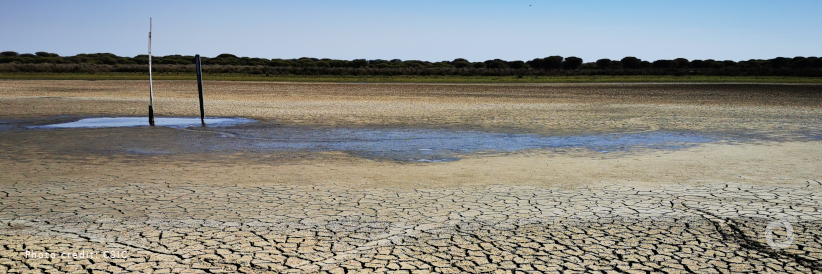Doñana, one of the most important wetlands in Europe and a World Heritage Site, is experiencing a disastrous year. All the lagoons in the National Park have now officially dried up as have the Doñana marsh and the Guadiamar stream.
WWF experts have visited the Doñana Biological Reserve, where the most important permanent lagoons are located, and have been able to verify first-hand that they are completely dry. The ‘permanent’ Santa Olalla lagoon was the last to dry up. It has been reduced to a small puddle, which no longer attracts birds. It is unlikely to harbour any fish or amphibians either due to its small size.
Other temporary lagoons, such as Charco del Toro and Taraje, have essentially disappeared and been invaded by vegetation that makes their future restoration and recovery more difficult.
It is only the third time that the lagoons have ever dried out and this year’s drought is one of the reasons why Doñana has reached this dire state. But it is not the most important.
“It is unacceptable that hundreds of illegal irrigation wells for berries and pools in beach resorts are being filled with water from the Matalascañas aquifer, while the Doñana National Park has dried up completely. The inaction of the administrations to protect one of the most important wetlands in Europe is inexcusable, especially when Spain has been condemned by the European Court of Justice for precisely this reason and must comply with the court’s order immediately. We are facing one of the worst moments in the history of Doñana. WWF is not going to stop campaigning to save this World Heritage Site and to ensure the administrations comply with their conservation obligations,” said Juan Carlos del Olmo, Secretary General of WWF.
According to the Doñana Biological Station (EBD), the most important reason is the alarming status of the Doñana aquifer. For the first time, the health of the aquifer under the lagoons is showing a significant negative trend and its status is classified as “alert”.
The main cause of the declining status of the aquifer in this area is the extraction of water for domestic supply, irrigation of gardens and filling of swimming pools in Matalascañas town, which swells from 2,000 inhabitants to more than 100,000 in summer.
This challenge is not new. Way back in 1988, the Hollis report commissioned by WWF warned of the possibility that the water table in the area of the lagoons would drop and they would disappear if pumping of water for Matalascañas continued. Indeed, it has increased over the past three decades. In addition, it must be added that the overexploitation of the aquifer by intensive and industrial agriculture – including illegal farms and wells – is affecting not only the aquifer, but also the flow of surface water into the marsh in such emblematic areas as the Guadiamar stream.
Doñana drying out has already impacted biodiversity. During this winter, the number of aquatic birds fell to 87,500 – less than 1/5th of last year’s 470,000. There have also been 20% fewer amphibians recorded compared to last year.
WWF is calling on national and regional governments to immediately take the necessary measures to protect Doñana and safeguard the services it provides to people and nature – before they disappear for good. For example, the authorities must order the immediate closure of the current wells that supply Matalascañas and their replacement by surface water in order to save the peridunar lagoons of Doñana from extinction. In addition, restrictions must be imposed on water usage in tourist resorts, including filling swimming pools and irrigating lawns.
The authorities must also begin restoration measures for the lagoons as well as implement the comprehensive recovery plan for Doñana – Plan Doñana 2030 – to save its marshes, lagoons and other ecosystems – and sustain the communities and nature that rely on them.

